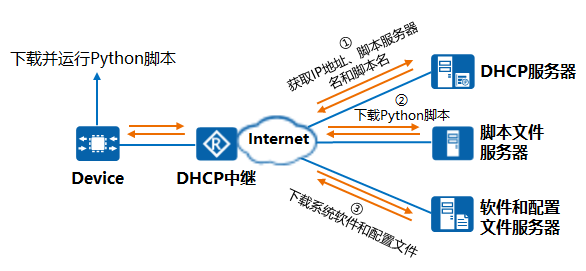Typical application scenarios of wireless screen projection OPS
Scenario 1: Equipment Inspection
Usually, when checking the health status of a device, users need to log in to the device and execute multiple command lines to view the hardware and business operation status of the device. Through the OPS function, users can customize policy deployments, and devices can automatically execute these status check commands, collect execution results on a regular basis, and send them to the server for analysis, reducing maintenance workload.

Scenario 2: ZTP automatic deployment
ZTP (Zero Touch Provisioning) can achieve automatic business deployment when the device is empty configured and started by calling OPS scripts. When the device is powered on with an empty configuration, it is necessary to obtain the address of the script file server through the DHCP server, obtain the Python script file from the script file server, and run it. Through the OPS function, run Python script files, download system software and configuration files from the server, and complete automatic deployment after restarting.

Implementing Automatic Deployment of Empty Configuration Devices through OPS
Scenario 3: Fault Handling
Users can perceive changes in the status of a board by subscribing to device management events opened by the system. In the event of a board failure, they can record the running status of the device and perform some fault handling operations by customizing actions.
Scenario 4: Intelligent Diagnosis and Intelligent Configuration
Through Python scripts, OPS can also be used to achieve intelligent diagnosis and intelligent configuration functions.
Example of intelligent diagnostic function
| function name | describe |
|---|---|
| Threshold alarm | Diagnose whether the memory and CPU usage of the diagnostic device exceed the threshold |
| Analysis of Routing Neighbor Information | Is the neighbor of the diagnostic device functioning properly |
| Interface information diagnosis | Is the diagnostic interface functioning properly |
| Routing diagnosis analysis | Check if the routing of the diagnostic device is normal |
| Monitor critical routing changes | Monitor real-time changes in critical routes and send log notifications |
| Equipment diagnostic information query | Is the diagnostic equipment functioning properly |
| Interface traffic information monitoring | Is the traffic of the diagnostic interface normal |
Example of intelligent configuration function
| function name | describe |
|---|---|
| Automatic configuration backup | Before starting configuration, automatically backup the current configuration to both local and remote servers |
| Change user information | When changing the configuration, record the username and IP address that changed the configuration |
| Risk warning | Before executing commands with high risks, add risk alerts |
| Configuration Wizard | When entering configuration mode, provide a wizard function to guide and simplify the configuration process |
| Close non essential services | When entering configuration mode, automatically monitor for non essential services, and if so, turn off the service |